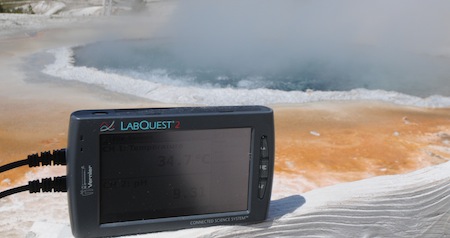Kicking the tires on the LabQuest 2 and its Connected Science System
By Martin Horejsi
Posted on 2012-05-23
A couple weeks ago, Vernier released their Graphical Analysis App for iOS providing a functional wireless interface with their LabQuest 2 and the iPad.
We took a LabQuest 2 and an iPad running Vernier’s Graphical Analysis App for a quick spin in Yellowstone National Park this weekend to explore the connectivity and general features. We found the LabQuest 2 an impressive combination of capabilities further dissolving the interference of the operation of the technology while preforming real-time data collection.
So in a nutshell…
Our data collection was focused on the temperature and pH. Initial runs used the LabQuest 2 as a standalone device. The sensor auto detect was quite fast, and the default display options were appropriate. Although the backlighting had to be turned to its brightest to see the display in full sunlight, glare was not as much of a problem as it is with the iPad’s glass surface. On a side note, polarized sunglasses have much less of an effect on the LabQuest 2 compared to the iPad that is only readable when viewing the screen in landscape mode requiring the use of the screen rotation lock switch to maintain viewing consistency.
As a quick data collection tool, the user interface and speedy startup of the LabQuest 2 is simple and fast enough eliminate the device as a barrier to use. Turn it on and go. Past probeware interfaces often required moments to minutes of setup that were sometimes just enough to prevent data collection on a whim.
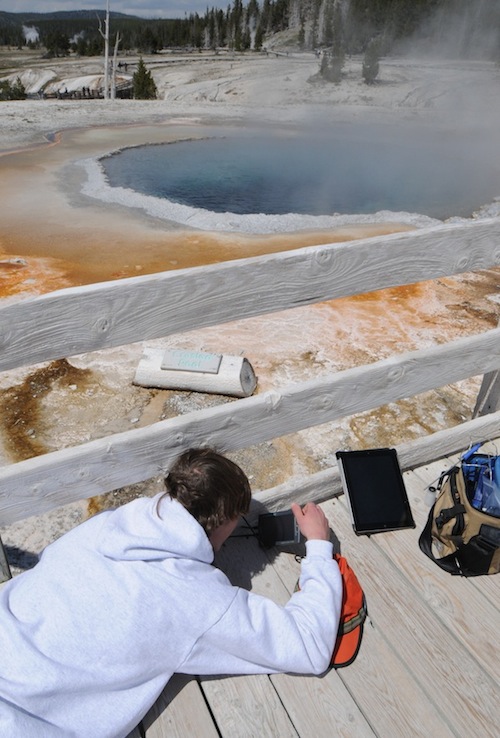
Yellowstone National Park provided the LabQuest 2 and iPad and almost infinite number of exciting data collections.
Connecting to the iPad was surprisingly quick given that the LabQuest 2 provides a scanable QR code for iPad to use rather than entering the IP address by hand. Using a QR code reading App (we used the App called Scan) and the iPad camera, the connection was made in a split second. Literally. And this is all done completely independent of an established wireless network as there were no other wi-fi networks nearby because our preliminary testing arena was none other than the geyser basin at the Old Faithful complex of Yellowstone Park.
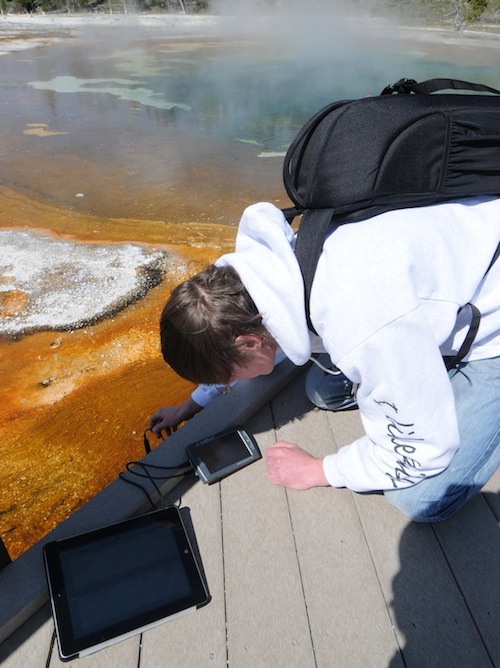
Yellowstone provided large number of data collection opportunities without breaking any of the park rules. Unlike the person in the video below from our trip to the Park last year
[youtube]http://www.youtube.com/watch?v=iu5p2HPyOwg[/youtube]
The high school student using the LabQuest 2 had never used a probeware interface before today, and only marginally experience with an iPad. The probes were dropped into the runoff streams from various geysers and hot pools. In one particular case, a small geyser eruption sprayed the LabQuest 2 while we watched the data stream on the iPad from a safe distance. It would make sense that sealing the LabQuest in a plastic bag as it feeds its radio waves to nearby iPads would dramatically increase the scope of outdoor data collection.
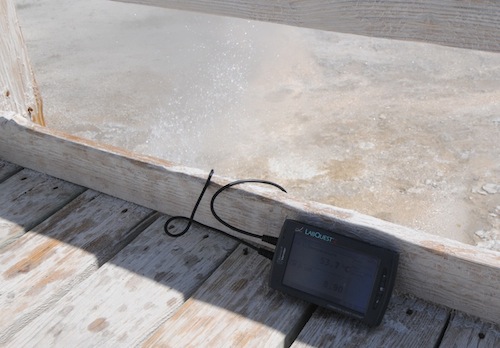
An erupting geyser splashes hot water on the boardwalk and LabQuest 2. We were standing a safe distance away watching the real-time data stream wirelessly to our iPad.
We did permanently lose the connection between the LabQuest 2 and iPad when both were turned off and then restarted, but when the LabQuest 2 was left on, the iPad had no trouble reconnecting after it would time-out or be shut off (but not fully shut down). However, the QR code made any necessary reconnection almost instantaneous. We had to shade the LabQuest 2’s screen to get the iPad QR code scanner to read.
Now that we have a better understanding of the connectivity-side of the LabQuest 2 and Graphical Analysis App, a more in-depth and deliberate inspection of the operating potential is needed. So stay tuned.
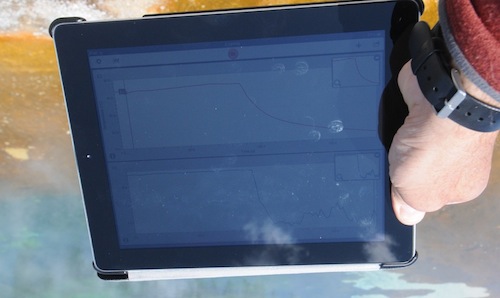
The large screen of the iPad is leveraged by the LabQuest 2 providing plenty of discussion real estate in a colorful multitouch environment.
It seemed obvious that the LabQuest 2 would be a real game changer in the data collection space, but after our field test, it seems more that the LabQuest 2 has invented an entirely new game. However, ultimately it falls on the teachers and students to truly imagine the potential of this technology. In fact, I’d even go so far as to say that human imagination is the main limit of Vernier’s Connected Science System right now.
Disclaimer: The views expressed in this blog post are those of the author(s) and do not necessarily reflect the official position of the National Science Teaching Association (NSTA).



